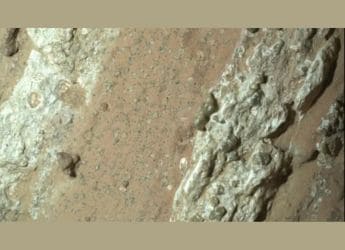- Home
- Science
- Science News
- NASA’s New Horizons Spacecraft Just Visited the Most Distant Object Ever Explored
NASA’s New Horizons Spacecraft Just Visited the Most Distant Object Ever Explored

Photo Credit: NASA
A NASA explorer is believed to have reached the solar system's outermost region early Tuesday morning, flying close to a space rock 20 miles long and billions of miles from Earth on a mission to gather clues about the creation of the solar system.
The body is farther from Earth than any other that has had such a close encounter with a NASA probe, scientists believe.
The New Horizons probe was slated to reach the "third zone" in the uncharted heart of the Kuiper Belt at 12:33am Eastern. Scientists will not have confirmation of its successful arrival until the probe communicates its whereabouts through NASA's Deep Space Network at 10:28am Eastern, about 10 hours later.
Once it enters the peripheral layer of the belt, containing icy bodies and leftover fragments from the solar system's creation, the probe will get its first close-up glance of Ultima Thule, a cool mass shaped like a giant peanut, using seven on-board instruments.
Scientists had not discovered Ultima Thule when the probe was launched, according to NASA, making the mission unique in that respect. In 2014, astronomers found Thule using the Hubble Space Telescope and selected it for New Horizon's extended mission in 2015.
"Anything's possible out there in this very unknown region," John Spencer, deputy project scientist for New Horizons, told reporters on Monday at the Johns Hopkins Applied Physics Laboratory in Maryland.
Launched in January 2006, New Horizons embarked on a 4 billion mile journey toward the solar system's frigid edge to study the dwarf planet Pluto and its five moons.
During a 2015 fly-by, the probe found Pluto to be slightly larger than previously thought. In March, it revealed that methane-rich dunes were on the icy dwarf planet's surface.
After trekking 1 billion miles beyond Pluto into the Kuiper Belt, New Horizons will now seek clues about the formation of the solar system and its planets.
As the probe flies 2,200 miles (3,500 km) above Thule's surface, scientists hope it will detect the chemical composition of its atmosphere and terrain in what NASA says will be the closest observation of a body so remote.
"We are straining the capabilities of this spacecraft, and by tomorrow we'll know how we did," New Horizons principal investigator Alan Stern said during the news conference at the Johns Hopkins Applied Physics Laboratory in Maryland. "There are no second chances for New Horizons."
While the mission marks the farthest close-encounter of an object within our solar system, NASA's Voyager 1 and 2, a pair of deep space probes launched in 1977, have reached greater distances on a mission to survey extrasolar bodies. Both probes are still operational.
© Thomson Reuters 2018
Get your daily dose of tech news, reviews, and insights, in under 80 characters on Gadgets 360 Turbo. Connect with fellow tech lovers on our Forum. Follow us on X, Facebook, WhatsApp, Threads and Google News for instant updates. Catch all the action on our YouTube channel.
Related Stories
- Samsung Galaxy Unpacked 2025
- ChatGPT
- Redmi Note 14 Pro+
- iPhone 16
- Apple Vision Pro
- Oneplus 12
- OnePlus Nord CE 3 Lite 5G
- iPhone 13
- Xiaomi 14 Pro
- Oppo Find N3
- Tecno Spark Go (2023)
- Realme V30
- Best Phones Under 25000
- Samsung Galaxy S24 Series
- Cryptocurrency
- iQoo 12
- Samsung Galaxy S24 Ultra
- Giottus
- Samsung Galaxy Z Flip 5
- Apple 'Scary Fast'
- Housefull 5
- GoPro Hero 12 Black Review
- Invincible Season 2
- JioGlass
- HD Ready TV
- Laptop Under 50000
- Smartwatch Under 10000
- Latest Mobile Phones
- Compare Phones
- Honor Win RT
- Honor Win
- Xiaomi 17 Ultra Leica Edition
- Xiaomi 17 Ultra
- Huawei Nova 15
- Huawei Nova 15 Pro
- Huawei Nova 15 Ultra
- OnePlus 15R
- Asus ProArt P16
- MacBook Pro 14-inch (M5, 2025)
- OPPO Pad Air 5
- Huawei MatePad 11.5 (2026)
- Xiaomi Watch 5
- Huawei Watch 10th Anniversary Edition
- Acerpure Nitro Z Series 100-inch QLED TV
- Samsung 43 Inch LED Ultra HD (4K) Smart TV (UA43UE81AFULXL)
- Asus ROG Ally
- Nintendo Switch Lite
- Haier 1.6 Ton 5 Star Inverter Split AC (HSU19G-MZAID5BN-INV)
- Haier 1.6 Ton 5 Star Inverter Split AC (HSU19G-MZAIM5BN-INV)

















